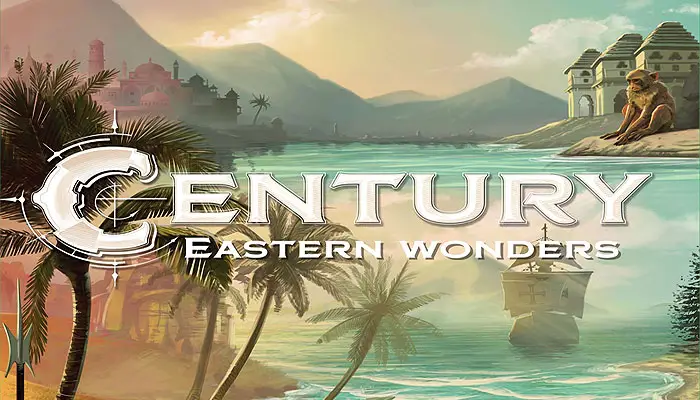
Centuries ago, the lucrative spice trade compelled the prosperous nations of the world to explore alternate routes to the sources of these precious goods. These nations took to the seas to seek out exotic lands.
This led to the discovery of the famed Spice Islands where the most valuable spices in the world were found. These spices were worth more than their weight in gold and some only grew on these islands. This discovery led to further expedition, competition... and later, war.
This era became known as the Age of Discovery. During this time of prosperity and opportunity, you find yourself traveling on the high seas in search of these exotic wonders . As a merchant and privateer representing your nation, you seek to control this region for glory and profit. Your journey continues in the Far East.
Setup
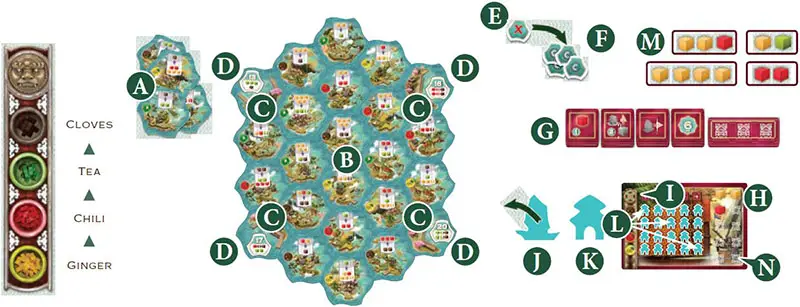
To set up a game of Century Eastern Wonders, follow these steps in order:
-
Sort all the market tiles
Aby trade symbol and randomly remove 1 tile of each symbol. Then shuffle the remaining market tiles. If it is your first game, build the map according to the pattern shown aboveB. If not, you may refer yourself to the "Create your own maps" section to learn how to make unique, customized maps! -
Place the 4 port tiles at each corner
Cof the map as shown above. -
Shuffle the Victory Point (VP) tiles without the Closed Port tile to form a pile, face down. Draw and place one face up VP tile on each port
D. Then, shuffle the Closed Port tileE, face down, among the first 5 VP tilesFof the pile. Finally, put these 6 tiles back on top of the pile. Put that pile on the table, next to the map. -
Sort all bonus tiles
Gby type and place them on the table. Form a pile with the 6 VP, 5 VP, 4 VP and 3 VP bonus tiles by sorting them in ascending order so the 6 VP tile is on top. -
Distribute a player board
Hto every player with the Eastern Wonders side face up, as shown above. The first player is determined by the player who was last on a boat. The first player takes the player board showing the First Player Icon on it
on it I. -
Each player then takes a boat
Jand all 20 outpostsKof the matching color. Each player places an outpost on each space of their player boardL. -
Place the starting cubes
Mthe middle of the table. In reverse turn order, each player will select their starting cubes, put them in their cargo holdNand place their boatJon any market tile. Once all players have selected their starting cubes, return any remaining cubes to the supply.
Game Turn
Century Eastern Wonders is played over a series of rounds . Each player will take one turn each round (starting with the first player and going clockwise).
On a player's turn, they may move their boat and then perform an action.
Move
You may move your boat to an adjacent tile for free A . Then, you may continue moving by placing a single cube B (of your choice) from your cargo hold onto each tile you leave C . You may continue moving this way as long as you have cubes available in your cargo hold.
When you end your movement on a market tile where one or more other boats are present , you must pay each of their owner 1 cube from your cargo. However, you cannot end your movement on a market tile where other boats are present if you don't have enough cubes to pay all concerned players.
If there are cubes on the tile where you have ended your movement on, you may place them in your cargo hold. If there are both boats from other players and cubes on the market tile you end your movement on, you must pay the concerned players cubes from your cargo hold first, before picking up the cubes.
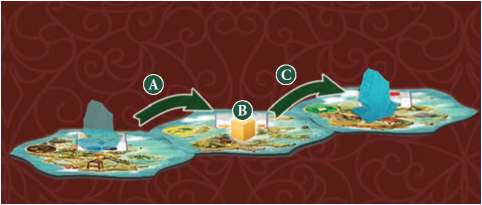
Action
After moving your boat (or chosing not to move), you may perform one of the following actions:
- a Market action on a market tile.
- a Port action on a port tile.
- a Harvest action on any tile.
Market

If your boat is on a market tile A, you first have the option to build an outpost on that tile B. You may build one of your outposts on a market tile if you don't already have one of your outposts on it.
The cost to place an outpost is 1 cube for each outpost currently on that market tile (2 cubes for each outpost in a 2 players game).
This means that building the first outpost on a market tile costs no cubes.

When building an outpost, pay the cost by returning cubes of your choice from your cargo hold to the supply, then take the left-most outpost from your player board from the row that matches the market's icon C and place it on that tile.
Lastly, after placing an outpost, if you empty a vertical column D, choose one bonus tile from the supply and place it next to your player board.

During movement, move to an additional adjacent tile for free.

Worth VP at the end of the game.

May upgrade 1 cube 1 level immediately after you build an outpost. It is also worth 2 VP at the end of the game.

Gain 1 additional red cube when you perform the Harvest action. It is also worth 1 VP at the end of the game.

Your cargo hold has 3 more spaces available for cubes.
Note: To perform an upgrade, return a single cube from your cargo hold to the supply and take one of the next level in exchange.

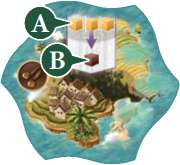
Once you have an outpost on a market, you may perform the Market action. You may trade the cubes listed above the arrow for those below the arrow from the supply.
During a Market action, a trade can be performed any number of times in a row as long as you have the appropriate cubes available.
Example: Tom has 9 yellow cubes and performs a Market action that allows him to trade 3 yellow cubes A for 1 brown cube B .Tom may trade 3, 6 or 9yellow cubes for 1, 2 or 3 brown cubes respectively.
Port
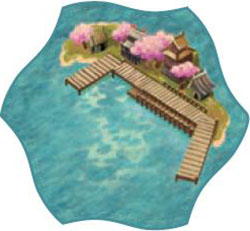
If your boat is on a port, you may claim the VP tile displayed at that port by returning the cubes shown on the VP tile from your cargo to the supply.
Take the VP tile and place it face down next to your player board. Then, draw the next VP tile from the pile and place it face up on the port tile.
If the tile is a Closed Port tile, the port is considered closed - meaning that VP tiles won't be placed on the port tile while it is present. From now on, if a VP tile is claimed in another port, first move the Closed Port tile to that port tile and then place a VP tile on the port that previously held the Closed Port tile.
Harvest
Take 2 yellow cubes from the supply and add them to your cargo hold.
Cargo Hold Limit
At the end of any turn, if you have more cubes in your cargo hold than spaces available, you must discard cubes of your choice until you reach your limit. Your cargo hold limit starts at 10.
End of the Game
The game's end is triggered once a player claims their 4th VP tile. The game will end after the current round of play.
At that point, players count all the points from their VP tiles, uncovered values from spaces on their player board, bonus VP tiles, and remaining cubes in their cargo hold (each non-yellow cube being worth 1 point).
The player with the most Victory Points wins.
If there is a tie, the last concerned player to take a turn wins the tie.
Create Your Own Maps
After their first game of Century Eastern Wonders, players may create their own unique maps.
When placing each tile, it is recommended to place it adjacent to at least 2 other tiles if possible.
Continue Reading



